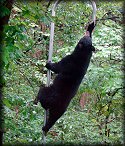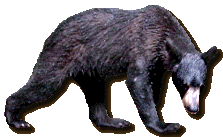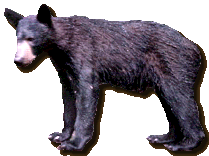|
Ursus americanus is found in North America. Although nocturnal, they can be seen anytime of the day or night. They have a home range of 8 to 10 miles, some up to 15 miles. They are generally solitary, except during mating season or mothers with cubs or yearlings. Black bears are capable of surprising speed, with bursts up to 30 miles an hour. They are powerful swimmers, and also climb trees, either for protection or food. And despite human pressures, the black bear still has one of the most extensive ranges of any big animal on the continent.
WHAT ARE BLACK BEARS? They are intelligent creatures with many learned abilities to utilize food and other resources in a wide variety of habitats. Bears seek foods high in protein and sugars and are able to extract protein from plants almost as efficiently as herbivores. They have a very acute sense of smell. Black bears are fiercely protective of their young, but are strict disciplinarians when teaching their young feeding habits, orientation, and fear of other bears and humans.
APPEARANCE: Adult black bears are between 4 1/2 to 6 1/4 feet long, with a shoulder height of 2 to 3 feet. Their fur color ranges from cinnamon to black to even white. In the eastern USA, they are black with a tan snout. Males are much larger than females. Females average around 155 pounds and males average 300 pounds, though both can weigh more. They have 5 toes on both fore and hind feet. They leave forefoot tracks that are 4 inches long and 5 inches wide, and hindfoot tracks are 7 to 9 inches long. They generally live about 10 years in the wild.
PICTURES: Lots of pictures are on a separate page found *** here ***.
WHAT THEY EAT: Although this animal is in the order Carnivora, black bears are omnivorous in diet. That is their diet consists mostly of vegetation, including twigs, buds, leaves, nuts, roots, fruit, corn, berries, acorns, and newly sprouted plants. But they will feed on plants, roots, carrion, small mammals, and garbage. A good sign that bears have been feeding around you is that logs or stones are turned over for insects; decayed stumps or logs are torn apart for grubs; ground is pawed up for roots; anthills or rodent burrows have been excavated; berry patches have been torn up; fruit-tree branches are broken; rejected bits of carrion or large prey are lying around. When food is abundant they may eat up to 45 pounds a day and gain 5 pounds a day to prepare for winter.
Above, as you can see, Mr. Bear is thirsty and will drink from the birdbath. He also pauses to look at the sculpture, "Mr. Peepers", that is on the retaining wall.
 Above, Mr. Bear is exhibiting the revolving feeder while standing on the "little bear" rock step to reach the feeder, because if you don't have a revolving feeder and step, you will probably loose your feeder. Above, Mr. Bear is exhibiting the revolving feeder while standing on the "little bear" rock step to reach the feeder, because if you don't have a revolving feeder and step, you will probably loose your feeder.  The picture (click to enlarge) to the right shows the degree to which Momma Bear will go to try and get a feeder, unfortunately for her, another bear beat her to it. This picture (click to enlarge) to the left, shows Mr. Bear using the "Little Bear" step to reach the feeder. He is still kind of a small bear. The picture (click to enlarge) to the right shows the degree to which Momma Bear will go to try and get a feeder, unfortunately for her, another bear beat her to it. This picture (click to enlarge) to the left, shows Mr. Bear using the "Little Bear" step to reach the feeder. He is still kind of a small bear.
We had been working outside, and had filled the feeder with birdseed using the milk jug scoop, when Mr. Bear stops by to see what we had. He grabbed the scoop, ran, but got disappointed with it being empty! So he just went home!
WHERE THEY LIVE: Black bears are found in forests, swamps, and the mountains. In the eastern USA, they are found primarily forests, mountains, and swamps; while in the west, in forests and wooded mountains seldom higher than 7,000'(2,100 m). Signs that bears live in the area are trees that are scarred with tooth marks, often as high as a bear can reach when standing on its hindlegs. Also higher, longer claw slash marks on trees, usually diagonal but sometimes vertical or horizontal. And in spring, rub marks and snagged hair on furrowed or shaggy-barked trees that are used repeatedly and by several bears as shedding posts, to rub away loose hair and relieve itching. The home range of the male is about double the size of that of the female.
BREEDING: Females usually first give birth in their 5th or 6th year, and then every 2nd or 3rd year after that. Black bears mate between June and early July, with cubs being born between January and early February. Generally, they have twins or triplets, but are known to have between 1 and 5 cubs. Usually only 1 cub is born the first winter that a female gives birth. The cubs are exceptionally small to the relative size of the mother. A mature sow can weigh up to 300 pounds, but cubs only weigh about 1/2 pound at birth.
GENERAL CHARACTERISTICS: In autumn they gain weight and retreat into dens under fallen trees, caves, or a protected spot. They sleep for several months, but do not trully hibernate since their body temperature does not drop drastically. They will wake several times in the winter and wander from their dens. Cubs are born during this time in the dens. All North American bears can be dangerous in the following situations: when accompanied by cubs, when surprised by the sudden appearance of humans, when approached while feeding, guarding a kill, fishing, when they are hungry, injured, or breeding, and when familiarity has diminished their fear of humans, as in some Canadian and U.S. parks.
 As this picture (click to enlarge) shows, they do have teeth. So,do not feed, approach, or get between a Black Bear and its food or cubs; it will usually flee, but can cause serious injury or even death. Black Bears can run up to 30 miles per hour and can climb trees. Campers must firmly seal up food and place it out of reach. Bears will break into unattended vehicles if they smell food in the vehicle, and they can smell anything through the car. As this picture (click to enlarge) shows, they do have teeth. So,do not feed, approach, or get between a Black Bear and its food or cubs; it will usually flee, but can cause serious injury or even death. Black Bears can run up to 30 miles per hour and can climb trees. Campers must firmly seal up food and place it out of reach. Bears will break into unattended vehicles if they smell food in the vehicle, and they can smell anything through the car.
Black bear cubs purr when fed and cry when hungry or cold. Adults huff and growl, roar, and chomp their teeth as warnings to other bears or to people. American black bears do not prey on humans, but sometimes they hurt or kill people in conflicts over space or food or while protecting their young. In most areas, American black bear populations are stable. Black bears are the most abundant of the species of bears. Mother bears have been observed urging their cubs to climb trees to flee danger and they discourage the cubs from climbing smooth-barked trees in favor of rougher-barked trees, which is easier for small cubs to climb. A black bear can use her mother's territory while her mother is still occupying it, so that they may learn survival practices while under the protection of the parent. Black bears make great mothers, they have even been persuaded to adopt orphaned cubs. Bear cubs express their emotions more clearly than adults, when a cub is very comfortable, especially when nursing, will give a call that is a comfort sound. A low squeal. They will also make the pleasing sound when expressing pleasure.
CLASSIFICATION: Black bears, Ursus americanus, are in the Ursidae family, and in the order Carnivora. The Ursidae family is made up of 8 species. Three are found in North America: the polar bear, the black bear, and the grizzly(brown) bears. At the subspecies level bears are hard to classify since they vary so widely in skeletal characteristics. Most bear specialists recognize 9 brown bear subspecies, 1 polar bear species, and up to 18 black bear species.
Bear Pictures
Home
Site Map
Email at: dh @ naturehaven.com
(Take out the spaces and this email address will work!)
Please Read Guestbook ~~~ Please Sign Guestbook
References and Links
- "Eastern Forests" by Ann and Myron Sutton
- "North American Wildlife" published by Reader's Digest
- eNature.com
- "Wild Animals of North America" published by The National Geographic Society
- "When Elephants Weep, The Emotional Lives of Animals" by Jeffrey Masson and Susan McCarthy
|





